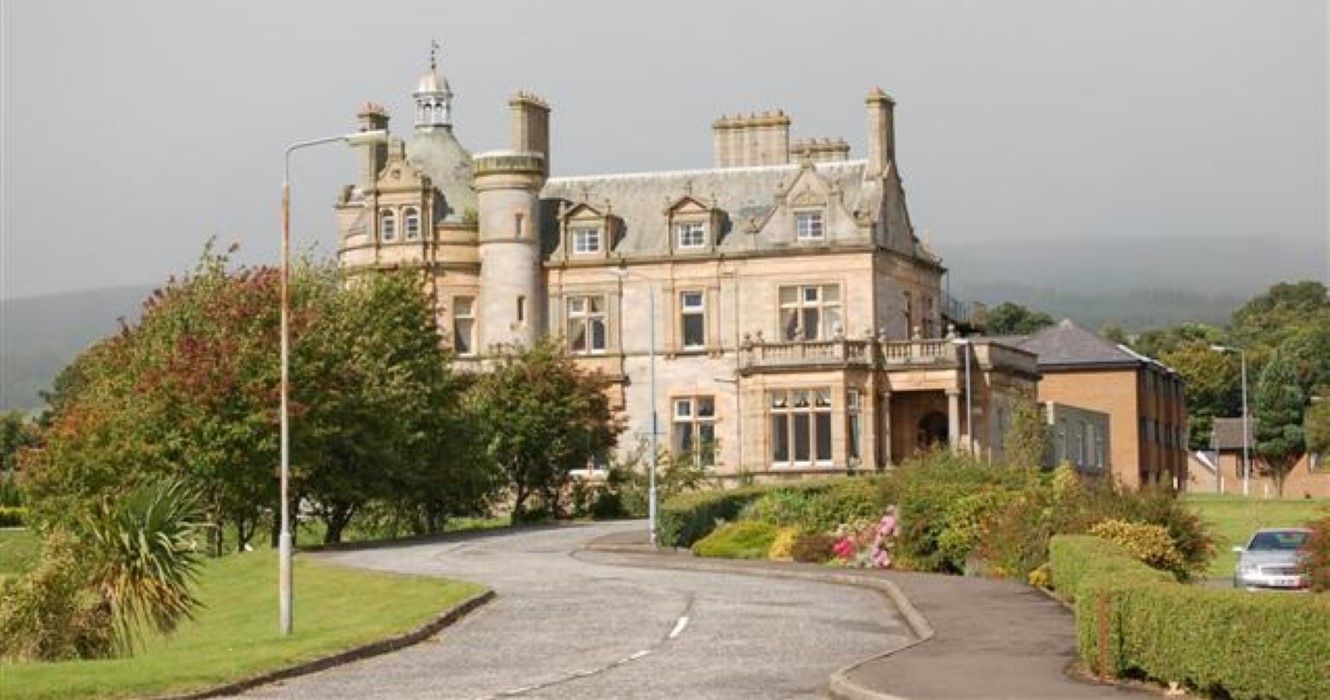Quick Links
On the coast of Antrim and just a half-hour drive from Belfast sits the rotting corpse of a once dazzling mansion. The Cairndhu House was once known for its enchanting gardens, decadent rooms, and glamorous parties. Today, however, it is more famous for its spirits and phantoms.
The UK is renowned for its haunted houses, hotels, and seasonal scary attractions. Northern Ireland upholds this reputation. With a grisly history and a beautifully gothic exterior, it is no wonder that Cairndhu House is dubbed the most haunted house in Ireland. For visitors wishing to explore the eerie side of the region, the estate is a must-see.
The Creepy History Of Cairndhu House
Cairndhu House was originally constructed in the 1870s. The wealthy textile merchant Stewart Clark built it on an estate of 100 acres, intending to use it as a summer retreat for his family. The mansion featured 60 rooms and extensive gardens. A wooden veranda was wrapped around its base, and a balcony decorated its upper floor. With delicate details and sloping roofs, the building was a fantastic example of Victorian architecture.
Its interior held a huge drawing room, billiards room, and smoke room. Schoolrooms and servants' quarters were also erected. The entrance hall was large and domineering. An ornate chimneypiece, carved with a scene from the life of Mary Queen of Scots, was the focal point of the house.
Its exterior was just as magnificent. A gate lodge, stables, and boat house decorated Cairndhu's immaculate grounds.
The Smith family were heavily involved in charity work. Mrs. Smith would play a key role in Irish temperance and regularly hosted philanthropic events at the property. This generosity would continue even when Cairndhu House was eventually sold.
The home was purchased in 1918 by Sir Thomas Dixon and his wife Edith Dixon, the youngest child of Mr. Clark. The couple would expand the property to 500 acres and renew the house with newer and grander rooms. Cairndhu would grow in fame for hosting illustrious dinners, garden parties, and galas.
Unfortunately, the house's opulence would soon be replaced by tragedy. During World War II, Cairndhu House was converted into a war hospital and supply depot. It would accommodate up to 40 patients at a time and was outfitted with examination rooms, as well as separate lounging and dining areas for males and females. While it attempted to be a place of comfort, despair descended on it as the war took its course.
Cairndhu House would eventually be fully dedicated to philanthropy. In 1947, the Dixons entrusted the building and its grounds to the government as a hospital and rehabilitation home. It would operate until 1986 when funding issues resulted in it being shut down.
The Ghosts And Graffiti Of Cairndhu House
Since its closure, Cairndhu House has fallen into a state of disrepair. Ceilings have collapsed, floorboards have rotted away, and its grand exterior has been smeared with graffiti.
Its gorgeous entryway has lost its opulence to damp, neglect, and vandalism. Exposed brick and crumbling wood have eaten away at the mansion's former glory. Its opulent staircase and hand-carved chimney have also unfortunately collapsed.
The damage has been so extensive that the public is no longer allowed to enter the house, which was once a pillar of its community.
Cairndhu House has been haunted by many reports of supernatural phenomena. Passersby have claimed to see ghostly faces peering through its shuttered windows. Phantoms have supposedly been caught strolling across its overgrown grounds. Visitors have alleged hearing disembodied banging, rustling, and footsteps.
Most disturbingly, photos of the property have appeared to show apparitions in period clothing floating where nothing was visible before. In 1992, a wedding party reportedly captured the ghost of a nurse in their photos, sadly gazing at the joyous crowd. It seems that despite Cairndhu House's fall into disrepair, it has continued to be a home... Just not for the living.
Explore The Former Gardens Of Cairndhu House
Although entry into Cairndhu is now forbidden, visitors can still explore its former land. Open every day of the year; adventurers can go on their own ghost-hunting expedition. The estate makes for a fascinating trip, and the overgrown grounds resemble a scene from a gothic horror story.
The northern section of the property has been absorbed into the Cairndhu Golf Course, while another portion has been converted into the Carnfunnock Country Park. Although the gardens have lost their neatness, the location still fosters an alluring yet unsettling atmosphere.
The location also provides many unique photo opportunities. Set against the backdrop of the Northern Ireland coastline, pictures are sure to enchant, even if they don't necessarily capture any phantoms.
How To Visit Cairndhu House
Located in Larne, on the coast of Antrim, Cairndhu House is easily accessible by car. Visitors can first visit Belfast, which features its own fascinating monuments and activities. Then, they can take the A8 and arrive within 30 - 40 minutes. On the way, they will be treated to a scenic view of Northern Ireland's coastline and greenery.
Visitors can also make the journey from Carrickfergus. This town is renowned for its cliff walk, castles, and witch trials. As a result, it is a great addition to any history or supernatural buffs exploring Cairndhu House. Ballyrickard Road connects the two within 30 minutes.
- Address: Coast Rd, Glenarm, Ballymena BT44 0BB, United Kingdom

